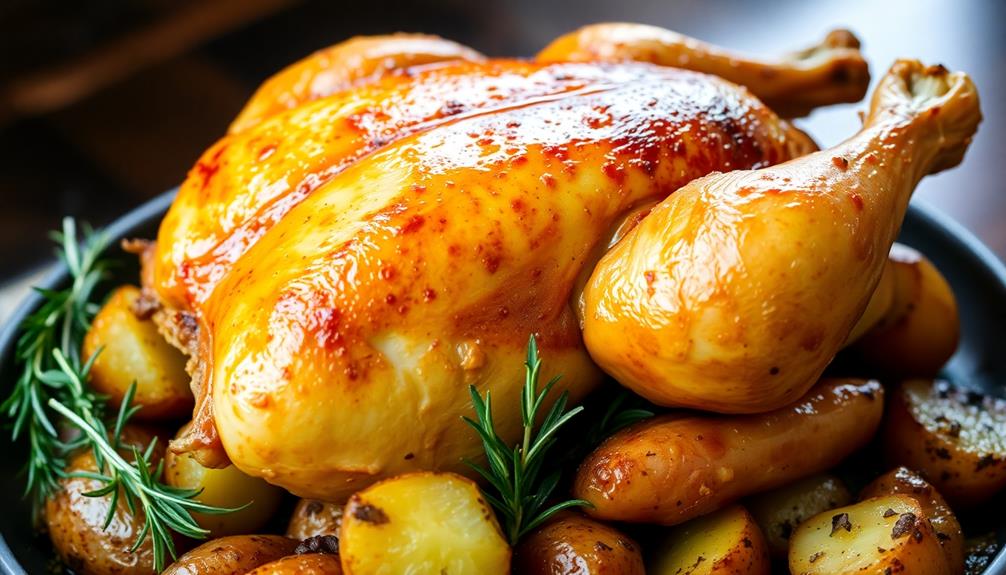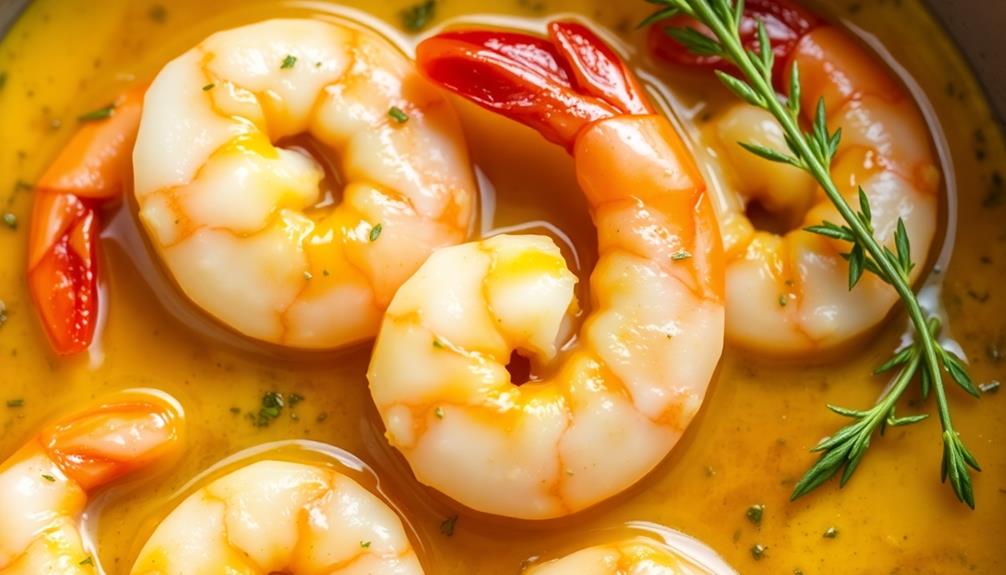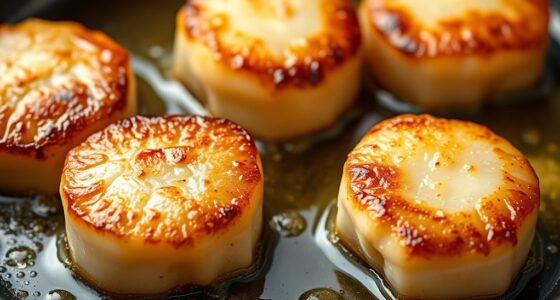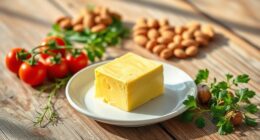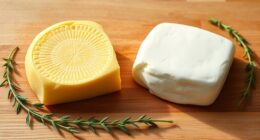French butter-roasted chicken is the ultimate comfort food – it's crispy on the outside, juicy on the inside, and bursting with rich, savory flavors. This classic recipe hails from rural France, where farmers and home cooks have perfected the technique over generations. The key is using high-quality butter to baste the bird, which infuses the meat with incredible depth of flavor. Paired with fragrant herbs and a bright touch of lemon, this dish is sure to transport you to a cozy Parisian bistro. Want to learn the secrets to achieving that perfectly crisp skin and tender, juicy chicken? Let's dive in.
Key Takeaways
- French butter-roasted chicken is a classic dish originating from rural France, known for its crispy skin and juicy, flavorful meat.
- The essential ingredients include high-quality unsalted butter, fresh herbs, and lemon, which infuse the chicken with deep, savory flavors.
- Proper cooking techniques, such as high-heat roasting and basting, are crucial for achieving the desired crispy skin and tender interior.
- Serving the chicken immediately after roasting, with the natural juices flowing, creates an irresistible dining experience that transports one to a Parisian bistro.
- The dish's enduring popularity in French cuisine and global appeal is a testament to its exceptional taste and ability to satisfy diverse palates.
History

Though the exact origins of the French butter-roasted chicken recipe are unclear, it's believed to have emerged as a regional dish in the rural areas of France, where farmers and home cooks had access to high-quality butter and fresh, free-range poultry.
Over time, this simple yet delicious method of roasting chicken in a bath of rich, creamy butter became a beloved tradition, passed down through generations.
The key to this recipe's success lies in the way the butter interacts with the chicken, creating a gloriously crispy skin that seals in the meat's natural juices.
As the chicken roasts, the butter bastes the bird, infusing it with a deep, savory flavor and a golden-brown hue that's simply irresistible.
This rustic technique, which allows the chicken's true character to shine, has endured as a beloved classic in French cuisine, capturing the hearts and palates of food lovers around the world.
Recipe
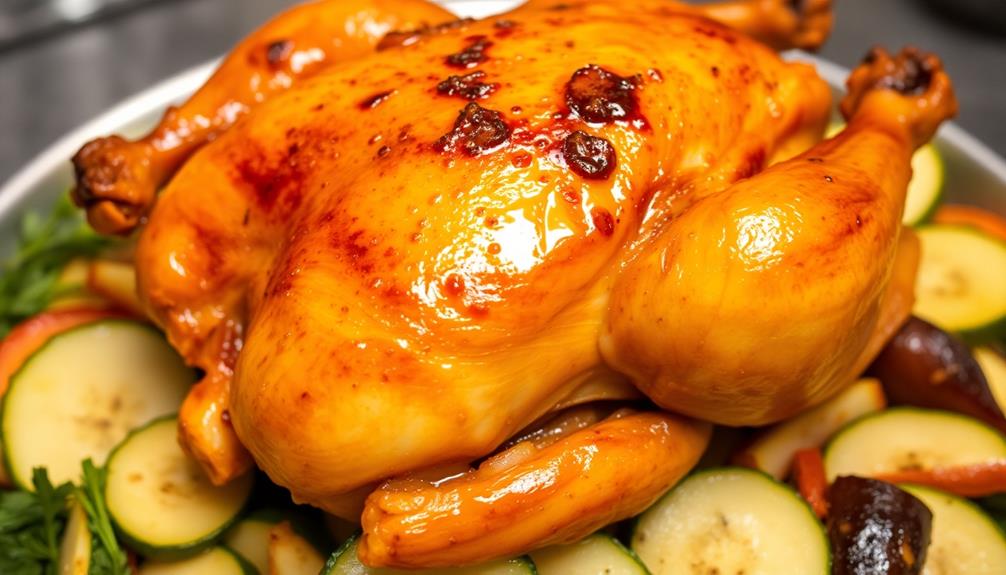
Roasting a chicken in butter is a classic French technique that produces a wonderfully crisp skin and juicy, flavorful meat. This simple recipe highlights the natural goodness of quality ingredients, allowing the chicken to shine.
Additionally, pairing your meal with a soothing herbal tea can enhance the dining experience; herbal teas like chamomile or peppermint can provide calming effects after a hearty meal, making them an excellent choice for relaxation herbal tea benefits.
At the heart of this dish is the use of high-quality, unsalted butter. The butter not only bastes the chicken as it roasts, but it also creates a rich, golden-brown crust on the skin. Pair this with a fragrant blend of herbs and a squeeze of lemon, and you have a truly delectable French-inspired roast chicken.
Ingredients:
- 1 (3-4 lb) whole chicken, patted dry
- 6 tbsp unsalted butter, softened
- 2 tsp fresh thyme leaves
- 1 tsp fresh rosemary, minced
- 1 tsp lemon zest
- 1 lemon, cut in half
- Kosher salt and freshly ground black pepper
Instructions:
Preheat your oven to 425°F. In a small bowl, combine the softened butter, thyme, rosemary, and lemon zest.
Generously season the chicken cavity and the outside of the bird with salt and pepper. Rub the herb-butter mixture all over the chicken, including under the skin.
Place the chicken in a roasting pan and squeeze the lemon halves over the top. Roast the chicken for 60-75 minutes, basting occasionally with the pan juices, until the juices run clear and the internal temperature reaches 165°F.
Allow the chicken to rest for 10 minutes before carving and serving.
For the best results, be sure to use high-quality, fresh ingredients. The combination of the flavorful herb-butter, the lemon, and the natural juices of the chicken create a truly delicious and authentic French-style roast chicken.
Enjoy this dish with a fresh salad or roasted vegetables for a complete and satisfying meal.
Cooking Steps
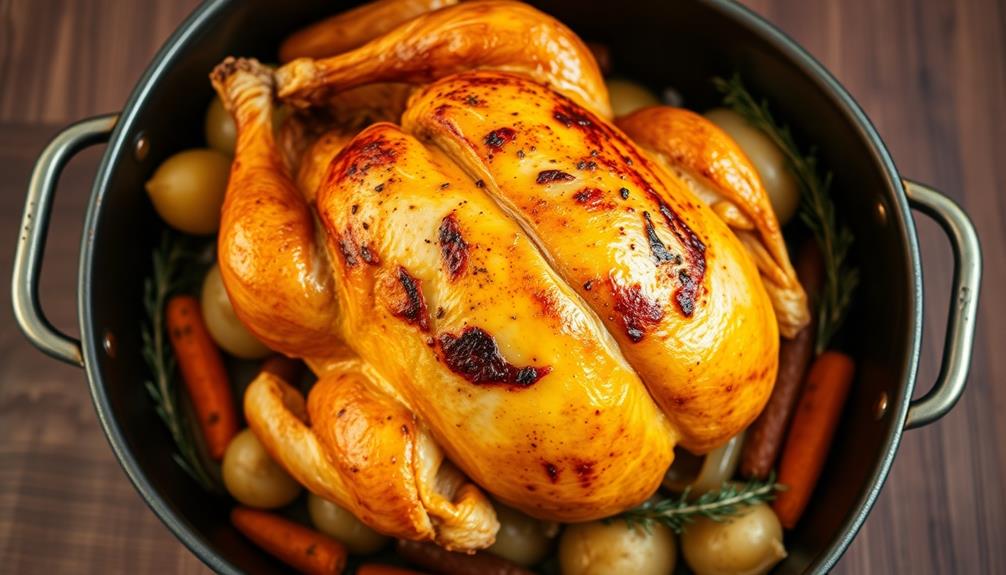
Preheat your oven to a toasty 425°F.
Pat that chicken dry, then coat it in a buttery mixture that'll make it extra crispy.
Roast the chicken until it's perfectly golden brown, then let it rest before serving – this ensures all those delicious juices stay right where they belong.
Step 1. Preheat Oven to 425°F
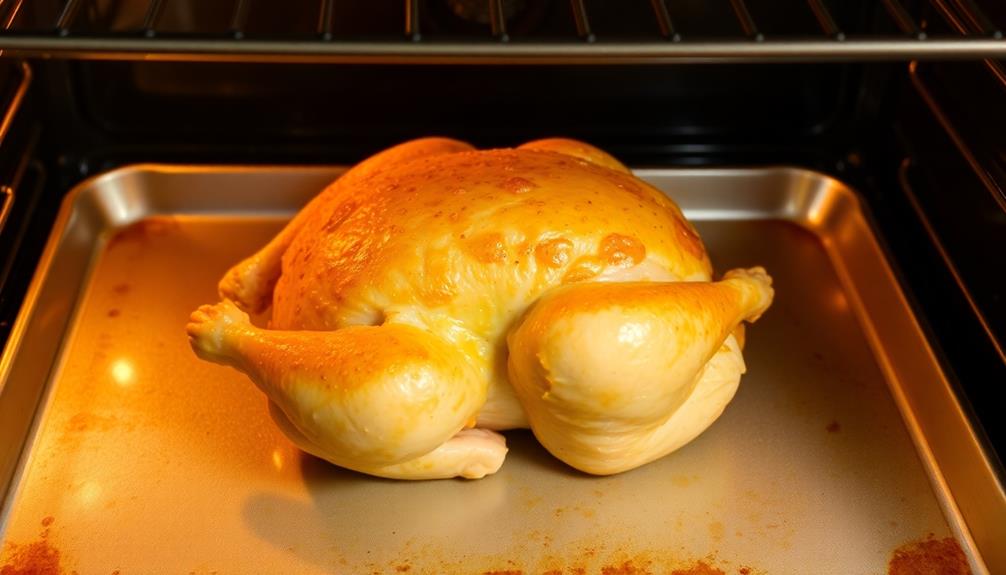
Begin by setting your oven to 425°F. This high temperature is essential for achieving the perfectly crisp skin that makes this French butter-roasted chicken so mouthwatering.
As the oven preheats, take a moment to gather your other ingredients and prep your work area. You'll want everything within reach for a smooth cooking process.
Once the oven has reached the desired temperature, slide the seasoned chicken into the hot oven. Listen as it sizzles, signaling the start of the roasting process. The high heat will rapidly render the fat in the skin, creating that delectable crunch you crave.
Set a timer to keep track of the cooking time, which should be around 45-60 minutes, depending on the size of your bird. Resist the urge to open the oven door too frequently, as this can disrupt the even cooking.
Instead, periodically baste the chicken with the flavorful pan juices to keep it juicy and infuse every bite with the essence of France.
Step 2. Pat Chicken Dry
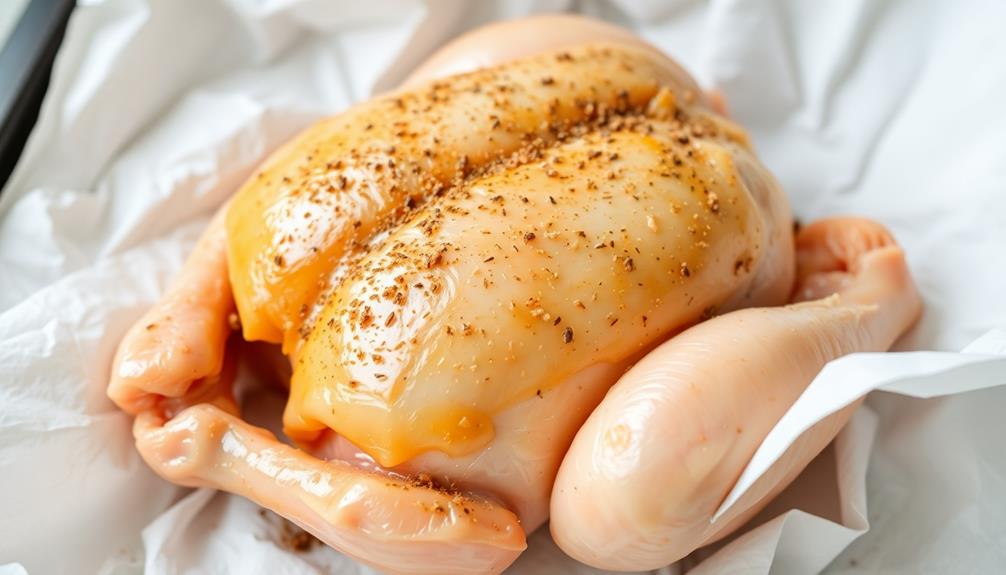
Before you place the chicken in the oven, pat it dry with paper towels. This crucial step helps create the perfect crispy skin that makes this French butter-roasted chicken so irresistible.
Gently blot the surface of the chicken, removing any excess moisture. Be sure to pay close attention to the nooks and crannies, as eliminating even the smallest droplets will lead to a superior texture.
Once the chicken is thoroughly patted dry, you're ready to move on to the next step. Rubbing the bird with an herbed butter mixture, which will infuse it with rich, decadent flavor as it roasts to golden-brown perfection.
The dry surface will also allow the skin to crisp up beautifully, locking in all those delicious juices. With just a few simple preparations, you're on your way to a mouthwatering French-inspired feast that's sure to impress your family and friends.
Step 3. Coat Chicken in Butter Mixture
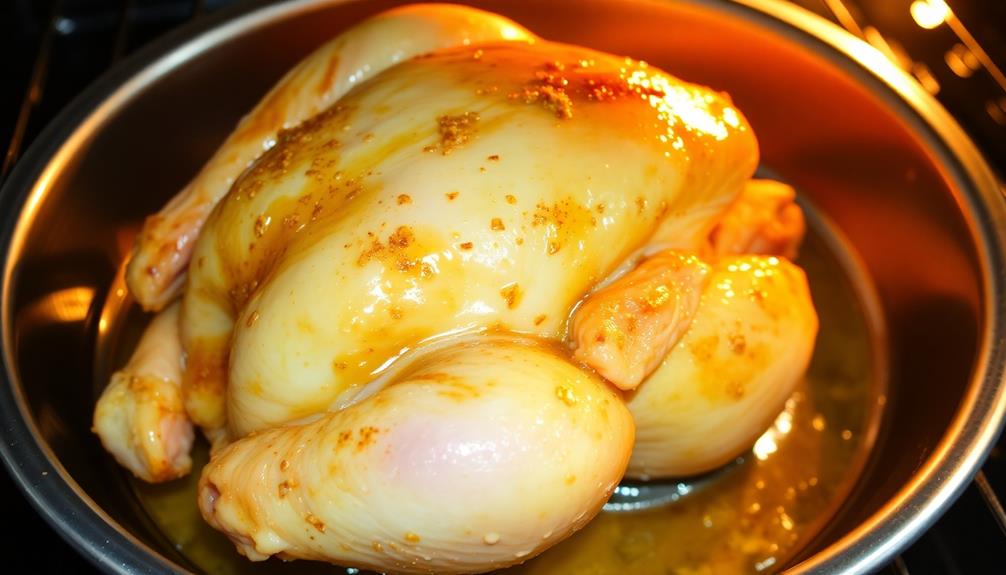
With the chicken now perfectly dried, you can move on to coating it in a delectable butter mixture.
In a small bowl, combine softened butter, minced garlic, fresh thyme, and a pinch of salt and pepper.
Use your fingers to gently separate the skin from the meat, creating a pocket. Carefully spoon the butter mixture under the skin, distributing it evenly over the chicken.
Rub any remaining butter mixture over the outside of the skin, ensuring the entire surface is coated.
This aromatic butter will melt into the meat as the chicken roasts, infusing it with incredible flavor and keeping the flesh juicy and tender.
Take a moment to admire your handiwork – the chicken is now ready for the oven, its golden skin glistening with the rich, fragrant butter mixture.
With this simple step complete, you're one step closer to enjoying a mouthwatering French-inspired roasted chicken.
Step 4. Roast Chicken Until Crispy
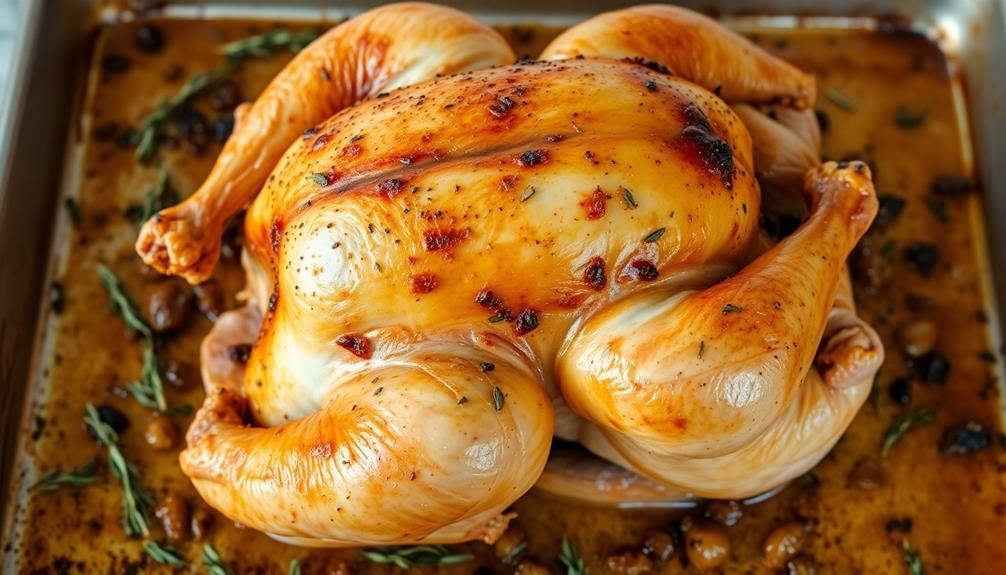
Preheat your oven to 425°F (220°C). Once your oven is nice and hot, it's time to roast that chicken to crispy perfection!
Gently place the chicken, breast-side up, on a rimmed baking sheet or in a large oven-safe skillet. Make sure to leave some room around the bird so the hot air can circulate and work its magic.
Pop the chicken into the preheated oven and let it roast for about 45-55 minutes. The key is to listen for that satisfying sizzle and watch as the skin transforms into a gorgeous, golden-brown hue.
Resist the urge to open the oven too often, as this can disrupt the steady heat and slow down the crisping process.
Use a meat thermometer to check that the internal temperature reaches 165°F (74°C) in the thickest part of the thigh.
When it's ready, the chicken will be moist and tender on the inside, with a delightfully crispy skin on the outside. Mmm, can you just imagine that first juicy bite?
Step 5. Let Chicken Rest Before Serving
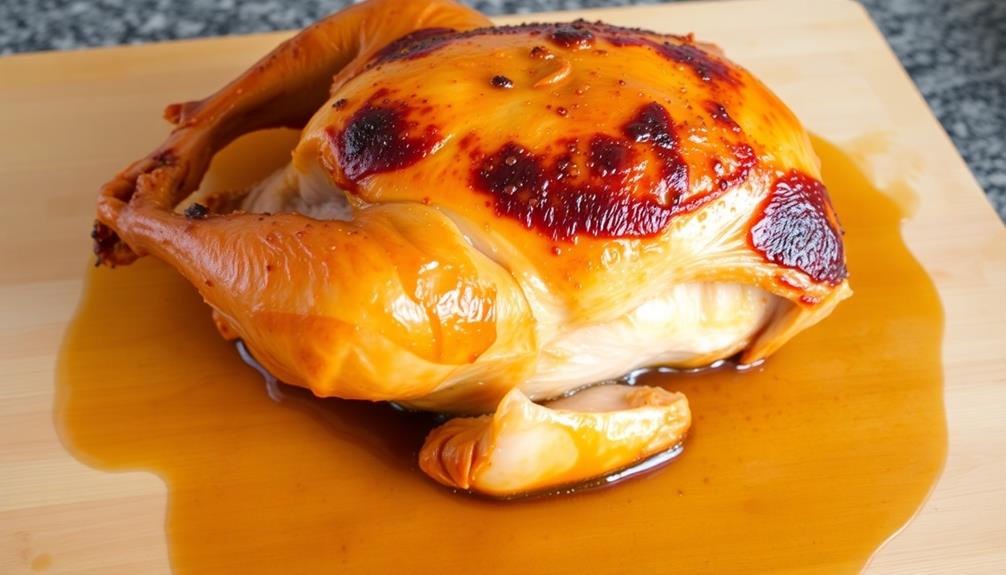
Once the chicken has reached the desired internal temperature, it's time to let it rest before serving. This crucial step allows the juices to redistribute evenly throughout the meat, ensuring every bite is moist and flavorful.
Just as aromatherapy can promote relaxation after a meal, resist the temptation to immediately carve into the bird – patience is key! Transfer the roasted chicken to a cutting board and cover it loosely with foil. Set a timer for 15 minutes and step away.
During this rest period, the temperature will continue to rise slightly, and the juices will have a chance to settle.
When the timer goes off, uncover the chicken and admire its beautiful, golden-brown skin. Use a sharp knife or carving fork to carefully slice into the meat. The juices should flow out easily, signaling that the resting time was well worth the wait.
Serve the tender, juicy chicken immediately, accompanied by your favorite sides. Your guests will be delighted by the succulent, french butter-roasted perfection.
Final Thoughts
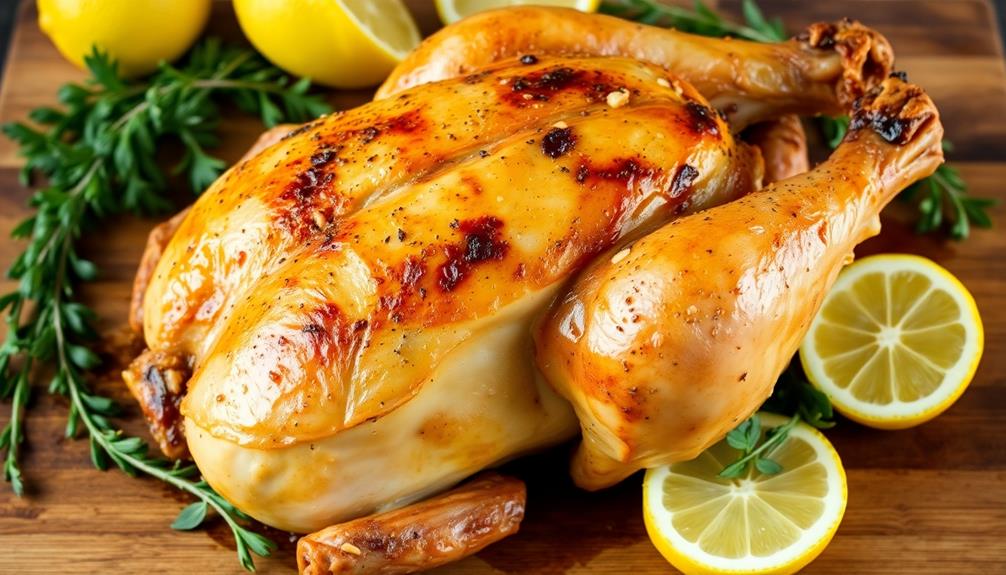
This French butter-roasted chicken is a true delight – the combination of crispy skin, juicy meat, and rich, flavourful butter creates a truly irresistible dish.
You'll feel like you're dining in a Parisian bistro as you savor each bite. The key is in the technique: basting the chicken with the fragrant, melted butter throughout the cooking process ensures every nook and cranny is infused with that incredible flavor.
And don't forget to let the chicken rest before serving – this allows the juices to redistribute, resulting in a perfectly moist and tender final product.
With just a few simple ingredients and some patience, you can bring a taste of France right to your own kitchen.
Frequently Asked Questions
How Long Does the Chicken Need to Rest Before Serving?
After cooking, the chicken needs to rest for about 10-15 minutes before serving. This allows the juices to redistribute throughout the meat, ensuring a tender and juicy result when you finally slice into it.
Can the Chicken Be Stuffed With Anything Else Besides Herbs?
Yes, you can stuff the chicken with a variety of ingredients besides herbs. Try onions, garlic, lemon slices, or even breadcrumbs and sausage for a unique twist on the classic roasted chicken.
Is It Possible to Use a Different Type of Fat Instead of Butter?
Absolutely! You can substitute the butter with other types of fat, like olive oil, coconut oil, or even bacon fat. These alternatives can provide unique flavors and textures to your roasted chicken dish.
How Can the Skin Be Made Even Crispier?
To make the skin even crispier, you can try using a higher heat to roast the chicken. Basting the skin with additional fat like oil or clarified butter can also help it achieve a crispier texture.
Can the Recipe Be Adapted for a Larger or Smaller Chicken?
Yes, you can adapt the recipe for a larger or smaller chicken. Just adjust the cooking time accordingly, monitoring the internal temperature to ensure it reaches the desired doneness. The basic method can be scaled to suit any size bird.
